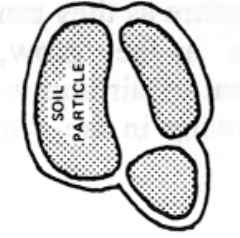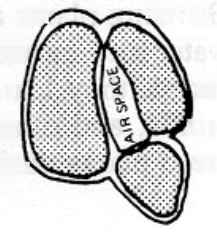
TOO WET |

IDEAL |

TOO DRY |
|
Then Suddenly It's Not! |
|
|

TOO WET |

IDEAL |

TOO DRY |
Sooner or later I just had to write a column about proper watering. I thought of writing about diseases, since this is always such an invigorating subject. If you follow my column, visit me in the store, or are subjected to one of my garden presentations, you will eventually hear me say "temperature and moisture, in conjunction with stress factors, cause a disease to thrive". I will address watering practices because we may as well get to the root of the problem, no pun intended.
While I always feel sad for flood victims, my motto is "Never curse the rain!". It's sort of like the old saying, "Be careful what you wish for, you just might get your wish". It does not take much drought to once again long for rain. The perfect moisture situation is a moderate amount of moisture. Excesses are our worst challenge.
In the first grade, we are taught that plants need air, light, and water. Air is also needed in the soil, with a perfect structure being 50% soil (mineral & organic matter), 25% air, and 25% water. The heavy clay of our area does not lend itself to pockets capable of harboring such volumes of air and moisture, but we still have this goal in mind, thus we aerate the soil. Lack of moisture kills roots through dehydration, but the soggy soils destroy roots through rot. Some bacteria thrive in wet conditions, which can lead to root diseases known to kill previously well established, healthy plants. Many other fungi and diseases also do very well in humid conditions above the surface of the soil. They're out there and they are simply awaiting their opportunity, much like a common cold germ waits for prone humans. Surely we all put wet towels in a laundry basket and forgotten them - gets pretty funky in a couple of days.
Proper watering means deep and infrequent watering. The plant needs to dry down a bit between waterings in order to restore air into the soil. If you are watering daily, you are either drowning the plant's roots, or you are promoting shallow root growth on the surface only. Either way, you are weakening or killing the plant. Deep and infrequent waterings allow the soil to dry and cause the roots to grows deeply, in search of moisture.
For lawns, this means water once or twice a week during dry periods at the rate of 3/4" of water twice a week or 1-1/2" of water once a week. (Sometimes you have to water more than once a week because the density of the soil will not allow enough absorption to take on 1-1/2" of water. For potted plants, one can tell by the weight of the pot as well as the appearance of the plant, when it is time to water. Many a good houseplant has been drowned. Gardens would follow a similar schedule to lawn watering, though lawns left unwatered for long periods of time will protect themselves by going dormant. Should you choose to water your lawn, remain faithful to this practice, or you will kill your grass by dragging it in and out of dormancy. Lawns consume a lots of water.
Two last critical pieces of advice. Don't water during the monsoon season! Fredericksburg had 11 inches of rain in June of 2000 (more than double the average). Some folks continued to use their irrigation systems. Improper use of irrigation systems is a common, but detrimental occurrence. Second, and lastly, calibrate your sprinklers. Using a straight sided can such as a coffee can, tuna fish can, etc. turn your sprinkler on and measure the length of time it takes for the can to collect a 1/2" of water. Now you know how long it takes your sprinkler (or irrigation system) to apply a 1/2" of water. See you next week.
***Images, complements of Virginia Master Gardeners
Andy Lynn